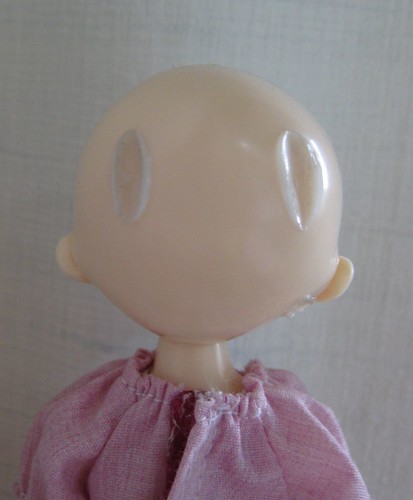The Cause of Doll “Melt”
Written on September 21, 2012 at 12:00 pm by MichelleFiled under: Article with tags: melting plastic
I’d like to preface this entry with the fact that I asked several coworkers from my summer employment (at a plastics manufacturing company) about what causes dolls to melt. They didn’t take me seriously at first until I showed them this photo of a Lino doll who’s head had melted against the legs of a Blythe (many thanks to Meg for allowing me to use this photo).
The coworkers that I had asked had a background in plastics, but it wasn’t until I asked a coworker who had a formal education in plastics and its properties that he understood what was going on.
You see, in many causes of reported dolls ‘melting’, it’s usually the hard plastic (e.g. pullring, head) touching the soft plastic (e.g. legs that can bend). The type of plastic used to produced the flexible legs of Blythe contain additives known as plasticizers. Plasticizers are what give the leg plastic the flexibility and ability to bend over and over again without breaking. If you were to try to bend the plastic of a Blythe’s head like you do her leg, the plastic used to produce the head lacks the plasticizer additives, the plastic would break instead of bend.
Plasticizers can migrate out of the plastic. This leads to the plastic being less flexible and more brittle. If you’ve ever seen an old electrical cord, you will have seen something that used to be flexible that has now become brittle and hard. Plasticizers can have reactions with other types of plastic, if they are touching. Normally plasticizers can remain ‘stable’ for years and years before migrating out, but several factors can come into play and cause the plasticizers to migrate faster.
The two main factors that increase plasticizer migration are:
- Exposure to heat. Heat makes molecules move faster and that makes the plasticizers migrate out faster. This also applies to exposure to direct sunlight.
- Exposure to pressure. If you were to stretch an elastic band (which contains plasticizers) over a long period of time, it does become brittle (and snaps!) faster than one that isn’t stretched continuously. If you rest something against the softer plastic, this can also cause plasticizers to leech out.
When plasticizers migrate out of an electrical cord, we normally don’t notice it. Cords are generally touching things that wouldn’t be harmed by the plasticizers. But when we put a doll on top of another doll’s legs, we notice it when we pick up our dolls.
Plasticizers can have reactions with other types of plastic. Even plastics that is normally considered highly stable, like ABS – which is what the Lino’s head is made of, can have reactions with plasticizers. The chemical reaction causes the ‘melt’ look that we see.
This also true for the ‘melt’ that is seen on Kenners that haven’t been stored in the most optimal of conditions. Their soft scalps are kept in close contact with the hard plastic of their heads and over the course of 40 years, reactions with the plasticizers do occur. Some Kenners have more ‘scalp ooze’ than others because they were kept in hot places. Kenners with less ooze were likely kept in cool basements or attics, in cooler climates or stored away in air conditioned environments.
Some things are more susceptible to plasticizer melt than others. Some people have reported their dolls’ shoes melting fairly quickly when its on their doll’s foot. When you consider how thin the plastic of the shoe is and the fact that there’s that pressure from the entire weight of the doll resting on the bottom of the shoe, it’s no wonder that the plasticizers can leech out. The weight of a doll may seem negligible to you, but it isn’t to the very thin plastic that makes up the shoe.
Why do some dolls melt and not others? That comes down to the environment that the dolls are kept in, if there’s any pressure against them, and also the batch of plastic used to produce the dolls.
The best way to keep your dolls from having melting issues is to store them in cooler areas of your house – definitely not in direct sunlight. You can also keep your dolls from melting by not storing them touching directly as the contact is the major factor in doll melt.
I hope this helps in answering some questions as to why dolls melt (sometimes) and hopefully you’ve learned how to prevent any future melting from occurring in your doll family.






 BlytheLife.com opened in July 2010 and is a blog and resource hub for all things Blythe!
BlytheLife.com opened in July 2010 and is a blog and resource hub for all things Blythe!




